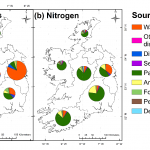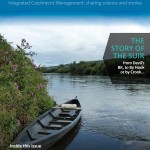New estimates indicate that diffuse sources outweigh point sources in…
Pesticides – modelling catchment management solutions
Throughout the UK, water companies are detecting pesticide concentrations above the regulatory drinking water standard in surface waters supplying their reservoirs and river intakes. Conventional water treatment can readily remove many pesticides but requires advanced treatment which has varying levels of effectiveness. With the Water Framework Directive discouraging additional treatment and encouraging up-stream thinking, catchment management is widely being considered as the solution to reducing pesticide concentrations.
Water quality monitoring in rivers and surface water abstractions throughout the UK reveals a widespread problem with pesticides such as MCPA, 2;4-D, metaldehyde, quinmerac and clopyralid occurring above the 0.1μg/l EU drinking water standard. Pesticides are used widely, particularly in agriculture, forestry, horticulture, transportation, amenity, and industry, so a proactive approach is needed to tackle the issue and prevent exceedances being recorded in drinking water supplies.
Given these recorded concentrations, water companies are taking action to meet these obligations set by the EU, and adhere to Article 7 of the Water Framework Directive to improve the quality of water used for public supply without commissioning additional treatment.
Catchment management can reduce the need for water treatment; improving the water environment and allowing water companies to meet their obligations in a cost-effective way. To ensure catchment initiatives deliver the maximum possible benefit to water companies and the environment we need to determine the sources of diffuse pesticide pollution and which areas of the catchment are contributing the most.
We have been working with UK water companies and regulators over the past seven years to help answer three key questions:
1. Will catchment management measures reduce diffuse pollution from agriculture in surface water sources?
2. If so, where will catchment management be most effective, and
3. What type of control measures and mechanisms should be promoted?
Approach
We developed a modelling approach to assess the effectiveness of catchment management for reducing pesticide concentrations at surface water intakes. We built robust catchment-specific models, calibrated for hydrology and water quality, and used these to simulate scenarios to test the potential effectiveness of targeted catchment management interventions.
Stage 1 – Catchment conceptualisation
We started each catchment study by taking a holistic approach to understanding the catchment and its water quality, integrating data on hydrology, hydrogeology, water quality and agronomy. We walked the catchments, and talked to local agronomists/agricultural advisors and stakeholders to build up an appreciation of each catchment. From this, we developed a conceptual understanding of each catchment, and sensitivity maps to help focus the modelling efforts. We use sensitivity maps to identify the locations of land uses and soil types that have the highest risk of pesticide runoff (and an example is shown Figure 1).
Stage 2 – Model build and calibration
Where the catchment conceptualisation indicates that the source of the water quality problem is likely to be derived from a specific subcatchment, we have used source apportionment analysis and simple reservoir balance models to determine if this is the case. This analysis provides a simple, cost-effective way to assess the likelihood of achieving regulatory compliance by targeting the problem subcatchment.
Where a more detailed approach is required we have used the Soil and Water Assessment Tool (SWAT) (http://swat.tamu.edu/) to simulate catchment hydrology and pesticide transport. SWAT predicts the impact of land management practices on water, sediment and agricultural chemical yields in large complex watersheds with varying soils, land use and management conditions over long periods of time. We use data on topography, soils, land use, geology, climate, cropping, water management, and pesticide properties in the catchment models. The hydrology of the models is calibrated against recorded flow data from gauging stations, and water quality is calibrated to pesticide monitoring data (an example is shown in Figure 2).
Stage 3 – Catchment management scenarios
Using the calibrated models, we simulate a series of catchment management scenarios, including no pesticide applications in specific areas of the catchment, and reduction of pesticide application rates. We use the results to determine which scenario is most effective at reducing pesticide concentrations, and which areas of the catchment contributes the most pesticide at the drinking water source. An example is shown in Figure 3, in which the model results suggest that implementing catchment management in the target areas shown could reduce metaldehyde concentrations in the reservoir by more than 95%.
We have found that, while the greatest relative reductions in pesticide concentration are predicted for interventions in high risk areas, these are often relatively small areas of the catchment, and measures are required over much larger areas to achieve the regulatory limit.
Outcomes Our clients use the results of our investigations to inform the conceptualisation of pesticide risks in their catchments and to quantify the potential benefits of implementing targeted control measures. Following on from this, results have been used in business planning, including justifying employing catchment advisors to work with farmers.
Based on the outputs of the model scenario outputs, Anglian Water have implemented their Slug It Out campaign 1 to encourage farmers to use an alternative to metaldehyde in the natural catchments of their reservoirs. This initiative has had great success, with 100% uptake in the catchments.1 www.anglianwater.co.uk/environment/our-commitment/ our-plans/slug-it-out.aspx
For Severn Trent Water our investigations have built on the modelling and included an ecosystems services appraisal and cost-benefit analysis. We used Environment Agency and UK Water Industry Research (UKWIR) tools to calculate benefit-cost ratios for the potential interventions and make recommendations on which to implement.
Catchment management techniques and policies continue to evolve, and so we are continuing to develop our approach. Our current work includes:
• Integrating the SWAT model with groundwater models to simulate nitrate transport.
• Updating the SWAT models to include new data, including feedback from catchment advisors, to increase our confidence in the results.
• Integrating the SWAT models into a cloudbased platform to forecast elevated pesticide concentrations and inform abstraction management.
• Considering natural flood risk management alongside water quality management. James Knightbridge, Nicola Nineham, Frances Elwell, Fintan McGivern and Paul Kelly, Catchment Management, Mott MacDonald
Acknowledgements
Anglian Water Services Limited, Severn Trent Water Limited Mott MacDonald is a multidisciplinary engineering, scientific, management and international development consultancy with offices in 150 different countries worldwide including Cork and Dublin in Ireland.







